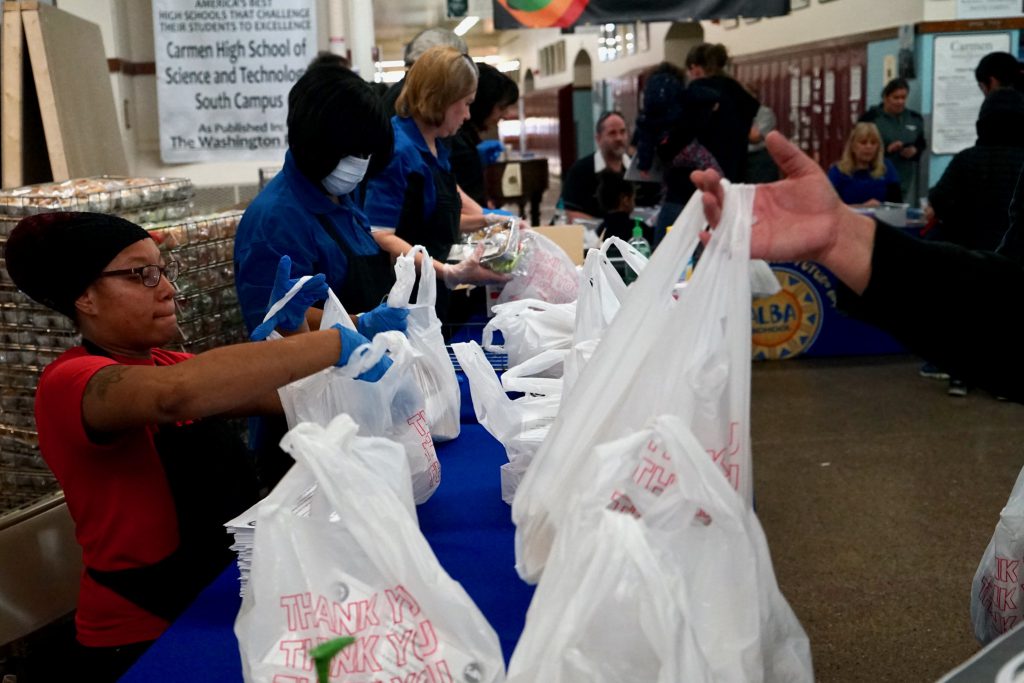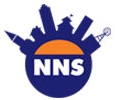Parents Eligible for Pandemic Food Aid
FoodShare funding reimburses parents whose kids under age 6 would have gotten free school meals.

If you have a child who was less than 6 years old on Oct. 1, 2020, and you were enrolled in FoodShare, you are likely eligible to receive money for meals, even if you picked up meals from school distribution sites like this one at ALBA School. Photo by Adam Carr/NNS.
If you have children who were younger than 6 years old on Oct. 1, 2020, then you are eligible to receive money to cover meal expenses incurred if you were already enrolled in FoodShare.
The money comes from the Pandemic EBT program, or P-EBT. P-EBT reimburses families with children who would have received free or reduced-price meals at school or child care but did not get the meals because their school or child care facility closed due to the COVID-19 pandemic.
Previously, this program was available only for parents of school-age children. But the federal government has created an additional P-EBT program to include children younger than age 6 who are not in school-so long as a family is not already receiving school-age P-EBT for a child.
To be eligible to receive this money, families must meet the following conditions:
- Have at least one child who was under age 6 on Oct. 1, 2020
- The household received FoodShare at some point since Oct. 1, 2020
- The household is NOT receiving P-EBT for school-age children
- The household lives in a county where at least one school had reduced hours or school closures during a given month to receive benefits for that month
Eligible families can receive $6.82 per child per day spent in virtual learning. The exact amount will vary based on how many schools in Southeast Wisconsin were learning in person compared with the number of schools learning virtually or using a hybrid model for a given month.
If the most common learning model in the region for a given month was fully in person with no virtual option, no child in the region will receive any pre-6 P-EBT. If the most common learning model was anywhere between in person with a virtual option and hybrid four days a week, all children in that region will receive 60% of the maximum pre-6 P-EBT benefit. If the most common learning model in the region was completely virtual, all children in that region will receive 100% of the max benefit.
The Wisconsin Department of Health Services, or DHS, said this approach is based on guidance from the federal Department of Agriculture, which approved DHS’ implementation plan for the program.
The Wisconsin Department of Health Services estimates that 92,000 families statewide will benefit from this program, which costs $68.6 million.
DHS leaders said in a public briefing this month that they are still working to confirm an implementation date for the Pre-6 P-EBT program and are working to set up a new system to provide the benefits to families. Families do not need to do anything to get these benefits. (For updates on when and how benefits will be distributed, text “MKE” to 73224.)
School-age P-EBT has begun catching up on missing payments
DHS is still taking applications for those who believe they are eligible to receive P-EBT but did not receive benefits on their QUEST card or did not receive a letter notifying them of their eligibility for P-EBT in March.
If you meet the following conditions, you are eligible to receive P-EBT benefits for school-age children:
- Your child’s school participates in the National School Lunch Program. A list of schools participating in the program is here.
- You are eligible for free or reduced-price meals
- Your child spent at least one day in virtual learning during the 2020-’21 school year.
If you meet these conditions but did not receive additional funds on your QUEST card or a P-EBT card in the mail in late March, you should be receiving them shortly.
To inquire about your benefits, call 833-431-2224 or email PEBTsupport@wisconsin.gov. The phone line is staffed with people speaking both English and Spanish, and a translation service is available for other languages, including but not limited to Hmong, Arabic and Somali.
This story was originally published by Milwaukee Neighborhood News Service, where you can find other stories reporting on fifteen city neighborhoods in Milwaukee.
More about the Coronavirus Pandemic
- Governors Tony Evers, JB Pritzker, Tim Walz, and Gretchen Whitmer Issue a Joint Statement Concerning Reports that Donald Trump Gave Russian Dictator Putin American COVID-19 Supplies - Gov. Tony Evers - Oct 11th, 2024
- MHD Release: Milwaukee Health Department Launches COVID-19 Wastewater Testing Dashboard - City of Milwaukee Health Department - Jan 23rd, 2024
- Milwaukee County Announces New Policies Related to COVID-19 Pandemic - County Executive David Crowley - May 9th, 2023
- DHS Details End of Emergency COVID-19 Response - Wisconsin Department of Health Services - Apr 26th, 2023
- Milwaukee Health Department Announces Upcoming Changes to COVID-19 Services - City of Milwaukee Health Department - Mar 17th, 2023
- Fitzgerald Applauds Passage of COVID-19 Origin Act - U.S. Rep. Scott Fitzgerald - Mar 10th, 2023
- DHS Expands Free COVID-19 Testing Program - Wisconsin Department of Health Services - Feb 10th, 2023
- MKE County: COVID-19 Hospitalizations Rising - Graham Kilmer - Jan 16th, 2023
- Not Enough Getting Bivalent Booster Shots, State Health Officials Warn - Gaby Vinick - Dec 26th, 2022
- Nearly All Wisconsinites Age 6 Months and Older Now Eligible for Updated COVID-19 Vaccine - Wisconsin Department of Health Services - Dec 15th, 2022
Read more about Coronavirus Pandemic here


















